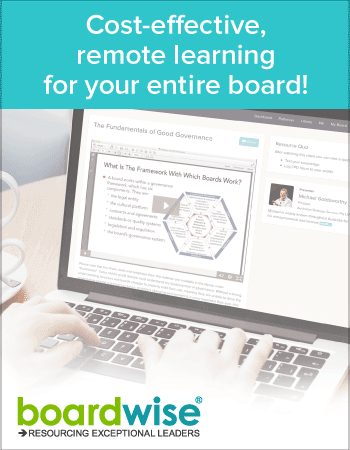Company Secretary Playbook: Effective Board Meetings
-
governance
Governance Company Secretary Playbook: Effective Board Meetings
Serving as the core of the governance team, the company secretary bears significant responsibility orchestrating productive board meetings. This requires extensive coordination across executives, chairs, directors and advisors to curate materials, set agendas, facilitate discussions, and document outcomes.
By following a rigorous preparation regimen, company secretaries can enable boards to achieve meeting objectives and maintain momentum between each meeting.
Getting Started: Laying the Governance Groundwork
Before planning individual meetings, the company secretary should advise and assist the chair in developing a board annual program of work (sometimes called a board calendar), mapping key topics and compliance requirements across the upcoming year. Maintaining a well structured program of work aids in scheduling meetings in a holistic way that factors in the myriad topics to be addressed across risk, operations, strategy and other key areas that require the boards attention.
The secretary should also regularly review charters, policies, director appointment paperwork, and onboarding programs to ensure foundational governance processes are sound. Regular monitoring of sub committee reports and proposed legislative changes helps to flag emerging issues that may warrant potential escalation to the full board.
With robust process and systems creating a governance infrastructure centred around consistent board operations, the secretary can devote more attention to planning individual meetings.
Crafting the Agenda: Determining Focus and Cadence
The agenda directly shapes meeting focus and effectiveness by framing discussions and prioritising precious time. Initial agenda planning should begin 4 weeks prior by convening the chair, chief executive officer (CEO) and company secretary to align on priority items for directors’ attention.
The CEO provides crucial context from managing daily operations on urgent business issues requiring deliberation or decisions. The chair contributes important perspective on strategic governance matters the board seeks to address. While the company secretary incorporates scheduled obligations like financial reports along with considerations like culture assessments or policy reviews based on the board’s annual work plan.
Since directors typically have heavy demands on their time and packed schedules, disciplined focus is vital.
The CEO, chair and company secretary should spend time to define what specifically requires the board’s time versus what falls within management’s purview, carefully removing topics that management can address directly without board input. Consider each topic’s impact on risks, performance and stakeholder interests when evaluating inclusion. Often difficult trade-offs are unavoidable to keep agendas targeted.
Beyond deciding what’s in and out, thoughtful agenda item sequencing means a logical agenda flow can be established, allowing sufficient time for substantive conversations when energy is high. Considering the time of the day of the meeting and inserting regular breaks will also assist in keeping attention and energy high through out the meeting.
Further to this it is worthwhile considering whether routine formalities like approving minutes should be shifted to the end of a meeting or moved into a block vote style agenda (also called Consent Agenda or Strategic Board Meeting Agenda) where all routine matters are passed under a single super or block vote.
The company secretary should clearly document conclusions on agenda topics, sequence, resources required, and approximate timing to shape subsequent planning.
Developing Robust Board Papers
With direction set, management assembles board papers conveying contextual insights on each item for directors to digest. The company secretary needs to partner closely with the CEO to spearhead paper development, ensuring materials meet established standards.
Initial drafts should be ready about 3 weeks pre-meeting to enable adequate review and refinement. The company secretary should carefully scrutinise papers to ensure they clearly communicate:
- The precise guidance, decision or input required from the board on each item
- Relevant background, risks, data and alternatives to inform judgments
- Provide answers to likely director questions to assist in providing clarity on the papers contents
The company secretary will then provide constructive feedback to focus and strengthen arguments. Editing aims to elucidate purpose and clarify the proposed path forward. Arguments should be honed to spotlight considerations requiring the board’s attention. The goal is for papers to directly address the crux of issues necessitating board input.
Finalised papers should be distributed 1 week before meetings barring emergencies. This provides sufficient time for directors to thoroughly analyse and absorb complex matters they will be expected to deliberate on.
Closing the Loop: Monitoring Progress on Action Items
Unresolved directives from previous meetings should be tracked on an action item register. The company secretary collaborates with management to prepare status updates on outstanding items for the upcoming board meeting.
For completed items, summarise how directives were addressed and results. For delayed items, delineate reasons for postponement and new timelines. Provide recommendations on any persisting open matters still requiring board direction.
Circulate a status report before meetings to efficiently verify satisfactory follow-through, preventing matters from repeatedly resurfacing.
Developing Minutes Templates to Streamline Documentation
With the agenda set and draft papers in hand, the secretary can begin constructing a minutes framework.
Start with sections for date, location, attendance, approval of prior minutes, and standard items. Draft consistent verbiage for recurring formalities like reviewing previous minutes or establishing next meeting dates.Populate placeholders for likely decisions based on scheduled paper topics and desired board outputs already signaled.
This draft structure focuses minute-taking on capturing substantive discussion points and resolutions rather than administrative minutiae. It also accelerates finalising comprehensive minutes soon after meetings conclude.
Calculating Resource Requirements
The secretary should estimate and arrange sufficient resources to support the meeting agenda. This includes securing meeting space with appropriate set up and equipment for scheduled presentations and breakouts. Virtual attendance resources may be needed for remote participants.
Verify the format of documentation directors require, whether printed board packs or digital materials. Arrange catering with consideration for dietary restrictions. Have name placards, stationery and reference materials on hand.
Addressing logistics proactively enables participants to focus wholly on content.
Managing Attendee Scheduling
Meeting invites should be sent to directors and confirmed attendees several weeks in advance. Send calendar holds or formal invitations indicating segments requiring each individual’s attendance.
Verify availability, re-confirm participation, and provide dial-in details and pre-reads closer to the meeting date. Reminder emails re-circulating the agenda and individual schedules minimise confusion. Meetings with robust advanced scheduling run smoothly and set a professional tone.
Briefing Presenters to Focus Discussions
The secretary should coach executives and others presenting to use time allotted as effectively as possible. Suggest highlighting key takeaways, decision points, and questions for discussion rather than information overload. Urge presenters to speak conversationally, engaging directors versus rigidly broadcasting slides.
To foster productive dialogue, highlight potential issues directors may zero in on based on the secretary’s assessment of paper contents. Discuss hypothetical scenarios and practice fielding challenging questions. Prepare presenters to listen intently and tailor responses based on directors’ perspectives. Enable presenters to speak directly to individual directors’ concerns when appropriate.
Conducting Final Reviews to Refine and Align
Shortly before disseminating materials, the secretary should rigorously re-review all board papers, presentations, minutes templates and supplementary documents seeking final refinements. Watch for statements straying from core topics or creating ambiguity. Assess whether arguments are balanced and even-handed or exhibit unsupported positions.
Consider whether information presented aligns logically with the established agenda flow and board sensitivities. Make any last recommended changes to sequence or emphasis accordingly. While additions may be infeasible this late, suggested modifications can still help prepare management to handle potential questions on underdeveloped points gracefully.
Executing Productive Meetings: Keeping Discussions Focused
With meticulous planning and preparation, the secretary can now focus fully on guiding productive discussions as the board convenes. The clear agenda allows the chair to efficiently steer conversations, maintaining focus on issues warranting attention. Presenters come armed with insights to address the board’s needs meaning that directors gain the contextual clarity required to offer thoughtful guidance aligned with organisational strategy.
The company secretary will need to track time closely relative to the agenda, keeping conversations moving at the appropriate pace. If discussions drift off-course, interject politely to re-centre attention on substantive topics requiring the board’s voice. Remaining time and pending items are reiterated to retain focus within the allotted schedule.
Since the minutes template captures procedural sections, the secretary’s notes can spotlight salient points made, key decisions, and follow-up actions agreed for later reference rather than attempting to transcribe all dialogue. If directors request additional data not immediately available, the secretary ensures the task is clearly defined and assigned noting it within the action list.
Where fruitful conversations flow beyond original time estimates, the secretary should consults with the chair on adjusting agenda prioritisation and sequencing accordingly. This allows adequate airtime for meaty topics while still addressing other priorities. Continual time checks ensure discussions remain tightly aligned with remaining meeting time.
Following Up to Maintain Momentum
To sustain the board’s progress, the company secretary should aim to swiftly finalises comprehensive minutes and circulating within 3 days post-adjournment. Minutes summarise substantive guidance offered, resolutions reached, and outstanding items delegated. The secretary reviews drafts with the chair to confirm accuracy before distribution.
Timely circulation enables promptly enacting agreed actions while discussions are fresh. Directors also immediately clarify any confusion before receding recall. Attaching an updated action list provides accountability for directives noting owners and deadlines. This timely follow-through demonstrates responsiveness and maintains a positive momentum for the board.
Continuously Strengthening Governance Processes
Post-meeting, the secretary should debrief with the chair, CEO and fellow directors to identify opportunities to enhance governance processes. Assess which discussions were most and least productive. Determine where additional context would have enhanced deliberations. Consider whether any participants were over or under-utilised based on expertise. Discuss adjustments to paper templates, presentation formats, and sequencing that would enrich engagement.
It is well worthwhile soliciting regular feedback from directors in the form of a short post meeting survey that address what works well, what doesn’t and ideas for improvements that could be made.
Regularly eliciting feedback allows governance practices to evolve aligned with the organisation and board’s needs. Insights gathered lead to continually elevating board performance. By consistently fine-tuning operations based on stakeholder input, company secretaries fulfil their vital role enabling excellence in governance.
Resources
What Does Good Governance Look Like?
Flying Minutes and Circular Resolutions
Your Guide to More Effective Board Meetings
10 Tips for Improving Your Board Meetings
Frequently Asked Questions
How do you conduct a board meeting as a company secretary?
A company secretary conducts board meetings by developing the agenda, assembling insightful papers, managing logistics, facilitating productive discussions, documenting outcomes, and performing follow-up. The secretary plays a pivotal role guiding impactful meetings from start to finish.
What does a secretary do in a board meeting?
In a board meeting, the secretary records minutes, tracks actions, manages time, and ensures discussions stay focused on agenda topics needing director input. An effective secretary enables constructive board-management dialogue.
Does the company secretary attend board meetings?
The company secretary typically attends and participates in board meetings to provide governance expertise, institutional knowledge, and procedural guidance to the board. Their involvement is key to ensuring adherence to governance protocols.
How do you make board meetings more effective?
Board meetings are made more effective through careful agenda shaping, concise papers, sequenced topics, prepared presenters, active facilitation, and quick follow-through on directives. Keeping discussions targeted optimises meeting productivity.
How a secretary should prepare for a meeting?
To prepare for a board meeting, a secretary should coordinate with executives on the agenda, review past materials, develop minutes templates, confirm logistics, and brief presenters on expectations. Thorough planning is crucial for the secretary prior to meetings.
What activities should a secretary carry out before a meeting is held?
Before a board meeting, a secretary should distribute the agenda, papers and relevant materials to directors, finalise logistical details, and remind required attendees. Proactive preparation sets the stage for smooth meetings.
How do you write minutes in a meeting as a secretary?
To write effective minutes, a secretary should capture key decisions, follow-up actions, and summarising points without attempting verbatim dialogue transcription Concise, accurate minutes provide vital documentation.



